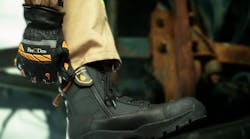You hear the word "metabolism" thrown around the firehouse gym and weight watchers meeting, but what is it?
Metabolism is the biochemical modification of substances in every living organism, usually consisting of sequences of steps called metabolic pathways. Low calorie dieting slows your metabolism, making it progressively difficult to lose weight and keep it off. Dieting fails because of a combination of hormonal changes, muscle loss, and repeated frustration.
If you persist with your self-imposed famine, you'll begin to break down muscle tissue for fuel. Ironically, when protein (muscle) is broken down, there's an immediate reduction in water weight, but this initial water weight-loss will be quickly regained as soon as you quench your thirst.
On the other hand, muscle is a calorically active tissue, as it requires a certain number of calories just to maintain itself. The more muscle you have, the more calories you burn - period, even while at total rest. It logically follows that if you lose muscle, your daily caloric requirement will skyrocket.
Not too many people, especially firefighters, can stick with a 1500-calorie-a-day diet for very long, and eventually you'll return to your old eating habits. Watch out when you do, because the weight, in the form of fat (say good-bye to any lost muscle unless you workout) will come rushing back. But I promise, there is a solution on www.firefightersworkout.com.
Two words, more muscle.
Before you run out and score some steroids, let's take a look at how the average firefighter, probie or seasoned veteran, can sensibly acquire some lean muscle mass, and avoid the grind of low calorie diets with endless cardio, and still build strength and endurance.
Don't Resist Resistance
How many diets have you been on? Do you look and feel any better as a result? That can all change with a simple, but well orchestrated approach.
The number one thing you can do for you body is allow it to work against a challenging level of resistance by employing a variety of exercises that simultaneously engage as much muscle as possible. If performed on a regular basis (two to six times per week), the results can be life-changing.
Within the framework of anywhere from five or 10 specific, functional and full body exercises, you can compile a program that will build real-life fitness. Exercises like the overhead press, push-ups, dead-lifts, and squats (and there machine variations), if performed in a certain fashion will dramatically change the way you look and feel in a rather short period of time (1 to 3 months). The training of both strength and endurance systems together is probably what's responsible for the exceptionally high and long-term metabolic cost, and its simultaneous ability to sculpt your body.
Dynamic Resistance Drills
Stop either drill at any time you hit extreme fatigue, DO NOT WORK TO MUSCLE FAILURE, regardless of overall sets.
Be flexible and change parameters (starting weight, reps, rest, number sets) often to keep your muscles guessing.
Start with any number of reps you can handle at VERY LOW muscle fatigue. You should rest anywhere from 30 seconds to 3 full minutes between sets. Below are two easy-to-learn examples.
Push-Up Endurance Ladder
You may substitute with the modified push-up, bench press, chest press, or standing shoulder press.
Start with any number of reps you can handle at VERY LOW muscle fatigue.
Rest anywhere from 30 seconds to 1 full minute between sets.
The Drill
Set 1: 10 reps (rest 30sec. to 1min.)
Set 2: 12 reps (rest 30sec. to 1min.)
Set 3: 14 reps (rest 30sec. to 1min.)
Set 4: 16 reps (rest 30sec. to 1min.)
Set 5: 18 reps (rest 30sec. to 1min.)
Set 6: 16 reps (rest 30sec. to 1min.)
Set 7: 20 reps (rest 30sec. to 1min.)
Go Back To Original Reps And Repeat Cycle (advanced)
Squat Strength Ladder
You may substitute with the dead-lift, lunge, step-up, or half squat.
Start with a resistance you can handle at VERY LOW muscle fatigue for 6 to 8 reps. Add 5 to 10 percent or the lowest amount possible over 10 percent. Rest anywhere from 1 minute to 2 full minutes between sets.
The Drill
Set 1: 8 reps with start weight (may be zero, rest 1 to 2min)
Set 2: 8 reps (add weight, rest 1 to 2mins.)
Set 3: 8 reps (add weight, rest 1 to 2mins.)
Set 4: 8 reps (add weight, rest 1 to 2mins.)
Set 5: 8 reps (add weight, rest 1 to 2mins.)
Set 6: 8 reps (add weight, rest 1 to 2mins.)
Set 7: 8 reps (add weight, rest 1 to 2mins.)
Go Back To Original Weight And Repeat Cycyle (advanced)
Please get clearance from you doctor before performing these exercises. This drill is designed to rev up your overall metabolism and should not be performed more than twice each week. For more fat-burning, metabolism revving drills, visit Captain Mike's website www.firefightersworkout.com
Eat Sensibly, But Often
Starvation doesn't work, ever! That's not to say you can eat whatever you want. Moderation, portion control, and the elimination of unwanted calories in the form of fried, processed, sugar-laden foods, as well as liquid calories, can cut overall caloric intake in half, while you still get to eat the same volume of food.
Stick with two or three healthful meals AND two or three healthful snacks spaced evenly throughout every day. It might help to keep a food diary of what you're currently eating (make no changes) and work on improving upon that. This process can be a real eye-opener, as well as allowing you to make very accurate caloric adjustments. Creating a deficit of 250 to 500 calories per day, will allow you to keep, and even build, muscle while your body fat melts away. Captain Mike also offers expert nutritional guidelines with his Custom Fitness and Weight Loss Program.
For more information about Captain Mike and his strength-building, fat burning workouts, please visit his website at www.firefightersworkout.com.
Michael Stefano, retired FDNY captain and author of The Firefighter's Workout Book also prepares customized fitness and weight loss programs, as well as wellness initiatives for individuals, large departments or corporations. For more information on Mike





